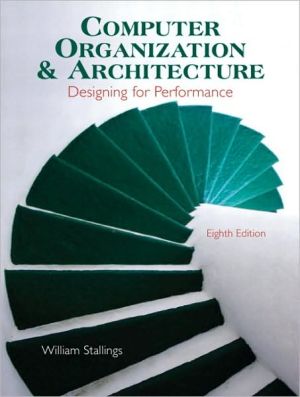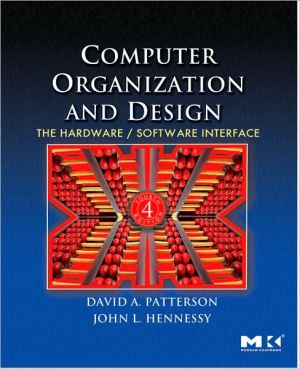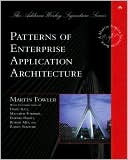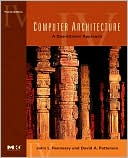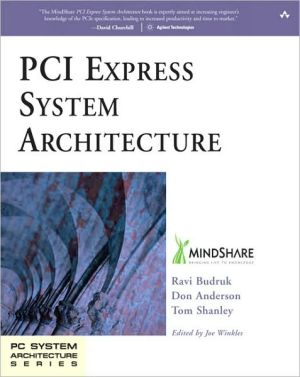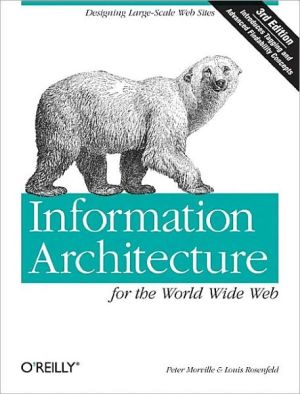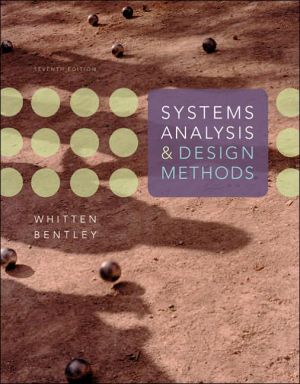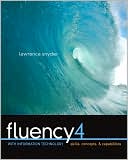Computer Organization and Architecture: Designing for Performance
Four-time winner of the best Computer Science and Engineering textbook of the year award from the Textbook and Academic Authors Association, Computer Organization and Architecture: Designing for Performance provides a thorough discussion of the fundamentals of computer organization and architecture, covering not just processor design, but memory, I/O, and parallel systems. Coverage is supported by a wealth of concrete examples emphasizing modern RISC, CISC, and superscalar systems....
Search in google:
KEY BENEFIT: Learn the fundamentals of processor and computer design from the newest edition of this award winning text. KEY TOPICS: Introduction; Computer Evolution and Performance; A Top-Level View of Computer Function and Interconnection; Cache Memory; Internal Memory Technology; External Memory; I/O; Operating System Support; Computer Arithmetic; Instruction Sets: Characteristics and Functions; Instruction Sets: Addressing Modes and Formats; CPU Structure and Function; RISCs; Instruction-Level Parallelism and Superscalar Processors; Control Unit Operation; Microprogrammed Control; Parallel Processing; Multicore Architecture. Online Chapters: Number Systems; Digital Logic; Assembly Language, Assemblers, and Compilers; The IA-64 Architecture. MARKET: Ideal for professionals in computer science, computer engineering, and electrical engineering. Booknews Addresses fundamental principles in computer organization and architecture and the critical role of performance in driving computer design, covering superscalar design, IA-64 design features, and parallel processor organization trends. Offers numerous ongoing examples, especially of Pentium, plus detailed treatment of bus organization, ISC, and I/O functions and structures. Pedagogical features include chapter outlines and problems, along with a web site, and projects and assignments available separately. This fifth edition contains expanded treatment of optical memory, superscalar design, and the MMX instruction set. Stallings is an independent consultant who has authored 17 books on computer science. Annotation c. Book News, Inc., Portland, OR (booknews.com)
PREFACE: \ PREFACE\ OBJECTIVES\ This book is about the structure and function of computers. Its purpose is to present, as clearly and completely as possible, the nature and characteristics of modern-day computer systems.\ This task is challenging for several reasons. First, there is a tremendous variety of products that can rightly claim the name of "computer", from single-chip microprocessors, costing a few dollars, to supercomputers, costing tens of millions of dollars. Variety is exhibited not only in cost, but in size, performance, and application. Second, the rapid pace of change that has always characterized computer technology continues with no letup. These changes cover all aspects of computer technology, from the underlying integrated circuit technology used to construct computer components, to the increasing use of parallel organization concepts in combining those components.\ In spite of the variety and pace of change in the computer field, certain fundamental concepts apply consistently throughout. The application of these concepts depends on the current state of the technology and the price/performance objectives of the designer. The intent of this book is to provide a thorough discussion of the fundamentals of computer organization and architecture and to relate these to contemporary design issues.\ The subtitle suggest the theme and the approach taken in this book. It has always been important to design computer systems to achieve high performance, but never has this requirement been stronger or more difficult to satisfy than today. All of the basic performance characteristics of computer systems, including processor speed, memory speed,memory capacity, and interconnection data rates, are increasing rapidly. Moreover, they are increasing at different rates. This makes it difficult to design a balanced system that maximizes the performance and utilization of all elements. Thus, computer design increasingly becomes a game of changing the structure or function in one area to compensate for a performance mismatch in another area. We will see this game played out in numerous design decisions throughout the book.\ A computer system, like any system, consists of an interrelated set of components. The system is best characterized in terms of structure-the way in which components are interconnected, and function-the operation of the individual components. Furthermore, a computer's organization is hierarchic. Each major component can be further described by decomposing it into its major subcomponents and describing their structure and function. For clarity and ease of understanding, this hierarchical organization is described in this book from the top down:\ \ Computer system: Major components are processor, memory, I/O.\ Processor: Major components are control unit, registers, ALU, and instruction execution unit.\ Control unit: Major components are control memory, microinstruction sequencing logic, and registers.\ \ The objective is to present the material in a fashion that keeps new material in a clear context. This should minimize the chance that the reader will get lost and should provide better motivation than a bottom-up approach. \ Throughout the discussion, aspects of the system are viewed from the points of view of both architecture (those attributes of a system visible to a machine language programmer) and organization (the operational units and their interconnections that realize the architecture).\ EXAMPLE SYSTEMS\ Throughout this book, examples from a number of different machines are used to clarify and reinforce the concepts being presented. Many, but by no means all, of the examples are drawn from two computer families: the Intel Pentium II, and the PowerPC. (The recently introduced Pentium III is essentially the same as the Pentium II, with an expanded set of multimedia instructions.) These two systems together encompass most of the current computer design trends. The Pentium II is essentially a complex instruction set computer (CISC) with a RISC core, while the PowerPC is essentially a reduced-instruction set computer (RISC). Both systems make use of superscalar design principles and both support multiple processor configurations.\ PLAN OF THE TEXT\ The book is organized into five parts:\ Part One— Overview: This part provides a preview and context for the remainder of the book.\ Part Two-The computer system: A computer system consists of processor, memory, and I/O modules, plus the interconnections among these major components. With the exception of the processor, which is sufficiently complex to be explored in Part Three, this part examines each of these aspects in turn.\ Part Three— The central processing unit: The CPU consists of a control unit, registers, the arithmetic and logic unit, the instruction execution unit, and the interconnections among these components. Architectural issues, such as instruction set design and data types, are covered. The part also looks at organizational issues, such as pipelining.\ Part Four— The control unit: The control unit is that part of the processor that activates the various components of the processor. This part looks at the functioning of the control unit and its implementation using microprogramming.\ Part Five— Parallel organization: This final part looks at some of the issues involved in multiple processor and vector processing organizations.\ A more detailed, chapter-by-chapter summary appears at the end of Chapter 1.\ INTERNET SERVICES FOR INSTRUCTORS AND STUDENTS\ There is a Web site for this book that provides support for students and instructors. The site includes links to other relevant sites, transparency masters of figures in the book in PDF (Adobe Acrobat) format, and sign-up information for the book's Internet mailing list. The Web page is at ...
Ch. 1Introduction6Ch. 2Computer evolution and performance16Ch. 3A top-level view of computer function and interconnection55Ch. 4Cache memory100Ch. 5Internal memory144Ch. 6External memory169Ch. 7Input/output200Ch. 8Operating system support243Ch. 9Computer arithmetic289Ch. 10Instruction sets : characteristics and functions334Ch. 11Instruction sets : addressing modes and formats386Ch. 12Processor structure and function415Ch. 13Reduced instruction set computers460Ch. 14Instruction-level parallelism and superscalar processors500Ch. 15The IA-64 architecture535Ch. 16Control unit operation571Ch. 17Microprogrammed control596Ch. 18Parallel processing638App. ANumber systems693App. BDigital logic700App. CProjects for teaching computer organization and architecture738
\ This textbook for a CS220 course identifies the function of the primary components of a computer system, then focuses in on the internal architecture of the central processing unit and the control unit. The Pentium 4 and PowerPC processors are highlighted. The sixth edition adds a brief discussion of synchronous DRAM and Rambus DRAM. Annotation c. Book News, Inc., Portland, OR\ \ \ \ \ BooknewsAddresses fundamental principles in computer organization and architecture and the critical role of performance in driving computer design, covering superscalar design, IA-64 design features, and parallel processor organization trends. Offers numerous ongoing examples, especially of Pentium, plus detailed treatment of bus organization, ISC, and I/O functions and structures. Pedagogical features include chapter outlines and problems, along with a web site, and projects and assignments available separately. This fifth edition contains expanded treatment of optical memory, superscalar design, and the MMX instruction set. Stallings is an independent consultant who has authored 17 books on computer science. Annotation c. Book News, Inc., Portland, OR (booknews.com)\ \
